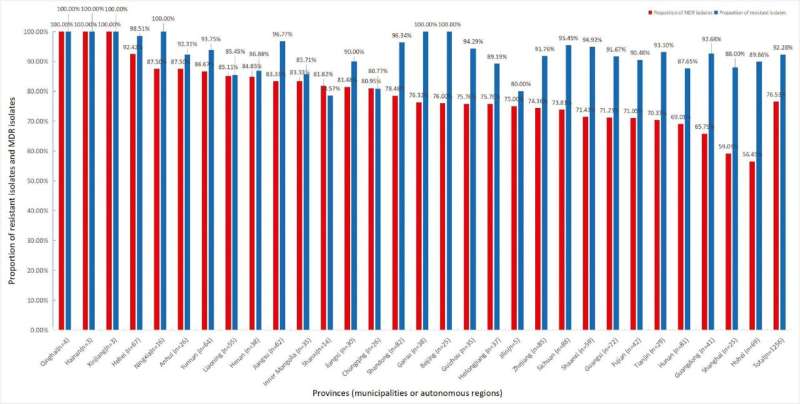This article has been reviewed according to Science X's editorial process and policies. Editors have highlighted the following attributes while ensuring the content's credibility:
fact-checked
proofread
Testing antimicrobial resistance in non-typhoidal Salmonella from retail foods collected in 2020 in China

Non-typhoidal Salmonella (NTS) is a major cause of human salmonellosis globally. Food animals are major NTS reservoirs. An increase in antimicrobial resistance (AMR) in foodborne NTS has led to clinical treatment failures. To examine the prevalence and perform characterization of foodborne NTS with AMR in China, the authors of a newly published article in Zoonoses tested the antimicrobial susceptibility of 1,256 NTS isolates cultured from retail foods in 2020 in China.
The antimicrobial susceptibility of 26 antimicrobial agents representing 12 classes was evaluated with the broth-microdilution method; the presence of 10 mcr genes was screened with multi-PCR. The complete closed genomes of mcr-gene-carrying isolates were generated by hybrid assembly through whole genome sequencing on both the PacBio and Illumina platforms. Genomic features and genetic environments of the mcr-1 gene were analyzed.
The overall drug resistance rate was 92.28%, and the multi-drug resistance (MDR) rate was 76.53%. A total of 341 AMR profiles were determined, and resistance was highest to nalidixic acid (63.38%). Among 887 NTS isolates with MDR, 232 showed co-resistance to cefotaxime and ciprofloxacin, and 25 were resistant to ten classes of antimicrobial agents.
The resistance of NTS isolated from different regions varied. Isolates from raw chicken sources most frequently showed resistance. Four NTS carried the mcr-1 gene and represented four different serotypes. Four mcr-1 gene-bearing plasmids from the four Salmonella isolates were classified into two replicon types (IncI2 and IncHI2A). Two mcr-1 genes in IncI2 type plasmids were found to be located between a PAP2 family protein-encoding gene and a relaxase-encoding gene, whereas the other two mcr-1 gene structures in IncHI2A type plasmids showed variations in the presence of insertion sequences.
The data demonstrated severe AMR among foodborne NTS isolated from food in China, thus highlighting the importance of antimicrobial susceptibility surveillance to decrease the spread of AMR, particularly to critical drugs in human medicine.
More information: Yujie Hu et al, Antimicrobial Resistance in Non-typhoidal Salmonella from Retail Foods Collected in 2020 in China, Zoonoses (2023). DOI: 10.15212/ZOONOSES-2023-0001
Provided by Compuscript Ltd



















